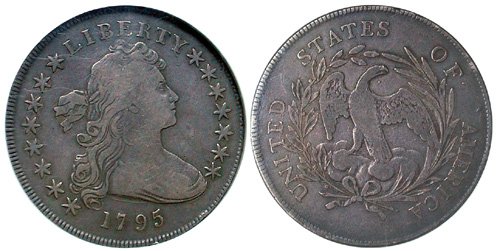Guide to U.S. Draped Bust Dollars
The Draped Bust Dollar was the second silver dollar type minted within the United States. The coins would be struck from 1795 to 1803 with two different reverse designs, creating two distinct subtypes. The production of the denomination would be halted, only to make an unexpected reappearance in 1834 when proof coins were struck carrying the 1804 date. With their unusual origin and limited mintage, these 1804 Draped Bust Dollars have come to represent one of the foremost rarities within American numismatics.

The Coinage Act of 1792 established the silver dollar as the largest silver denomination within the American monetary system. Like the previous series, the new Draped Bust Dollar was designed by Robert Scot, the first Chief Engraver of the United States Mint. His new obverse design was based on the work of portraitist Gilbert Stuart, who had used Philadelphia resident Ann Willing Bingham as a model. This rendition of Liberty would be featured on the remaining silver denominations of the era and now provides a familiar image for collectors of early American coinage.
The obverse of the coin features the head of Liberty, facing right with her bust partially draped. An arrangement of stars appears to each side of Liberty, representing the states in the Union. Initially, stars were added to the design as more states joined the Union, but it was soon decided that the Mint could not add stars indefinitely. Thus, after using 15 and 16 stars, the number was reverted to 13 stars, representing the original thirteen states. The design is completed with the word “LIBERTY” above and the date below.
The reverse of the issues dated 1795 to 1798 was based on Scot’s earlier work, which had appeared on the reverse of Flowing Hair half dimes, half dollars and silver dollars. The design features an eagle at the center, encircled by a wreath with the top slightly open. The eagle stands on a bank of clouds, just above a ribbon which holds the wreath together. The words “UNITED STATES OF AMERICA” appear surrounding. No indication of denomination is given, rather this is included on edge lettering of the coin reading “HUNDRED CENTS ONE DOLLAR OR UNIT”. This is referred to as the “small eagle” reverse.

During 1798, a new reverse design would be introduced for the Draped Bust Dollar as well as other silver coinage. The design features a heraldic eagle based on the Great Seal of the United States. The eagle has a shield at its breast with its wings and claws spread. The eagle’s talons grasp a bundle of arrows and an olive branch, while its beak holds a ribbon with the inscription “E PLURIBUS UNUM”. An arrangement of clouds and thirteen stars appear above the eagle, with the words “UNITED STATES OF AMERICA” surrounding. Once again, the denomination appears as edge lettering.
Production of this second subtype known as the “Heraldic eagle” reverse would continue until 1804. During that year, production consisted of coins from dies dated 1802 or 1803. Using prior-year dies was a common practice at the early Mint, as it saved money to use the dies as long as possible. This would have been the end of the series, however due to an unusual set of circumstances, silver dollars carrying the 1804 date would be produced in 1834 and subsequent years.

